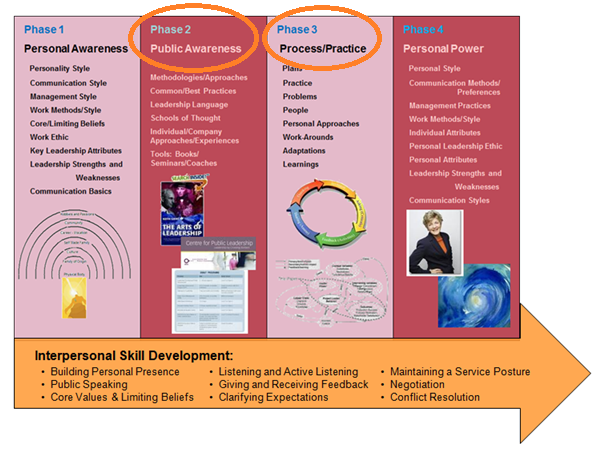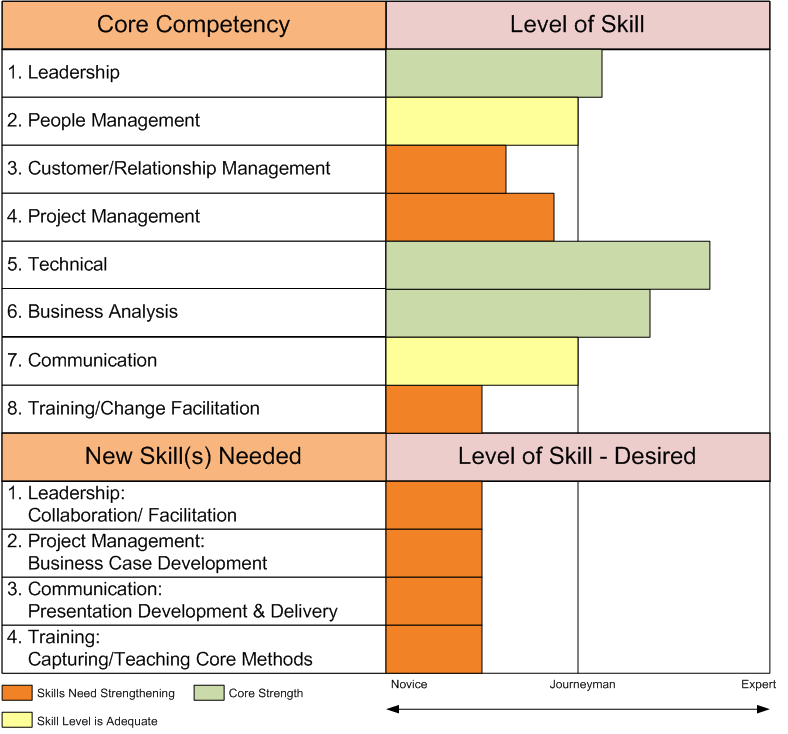Strong Point’s Leadership Rule #24: Share Your Methods
Strong Point Strategy has developed and maintains a 4-Phased Methodology for Leadership Development. Strong Point’s Leadership Methodology is based on Strong Point’s unique definition of Leadership:
Leadership is the aggregate strength derived from the use of deep reservoirs of personal awareness, skill, and professional best practices. These best practices and methods are then uniquely applied to a set of challenges that call out individual authenticity and set new precedents in a professional capacity and personal effectiveness to support the common good.
Phase 1 of Leadership Development, according to Strong Point’s method, requires leaders to thoroughly audit their core skills, styles, strengths, values, and beliefs. Assessments of personality style, preferred management style, commanding communication and learning styles, and critical thinking styles can all be determined and evaluated through thoughtful reflection during this Phase. In Phase 1, leaders work to gain a strong sense of their own self- image, as well as concretely understand the perceptions and impressions others have of them. This pursuit of self-knowledge that continually poses the question “Who am I?” when faced with critical decisions or dilemmas, is a life-long leadership development process. A core body of evidence, though, and a core internal profile is necessary to effectively and consciously begin the process of Leadership Development. Leaders, like businesses, have to benchmark their strengths before attempting to advance and grow.

Phases 2 and 3 of Strong Point’s Leadership Development Methodology focus on learning other leaders’ core methods. In Phase 2, Strong Point works with leaders to develop well-rounded exposure and competency in a core set of methods that are considered Industry Standard. Some of these recommended core methods include but are not limited to:
Management and Operating Model Development and Operations Critical Thinking/Decision Making Business Finance and Budget Management Project/Program Management Business Analysis Skills Software Development LifeCycle (SDLC) Product Development/Design Thinking Lean/Six Sigma Process Control Quality Management Customer Engagement/Service Methods Consultative or Product Selling Instructional Design Methods
Competency in methods of execution can be obtained and learned through certificate programs, community colleges and universities, maters programs, professional institutes, organizations, and other credentialing bodies. Phase 2 of Strong Point’s Leadership Development Model requires leaders to gain certified knowledge of a particular method or set of practices or techniques. Examples include gaining a Project Management Certification (PMP) or becoming an Agile Scrum Master. Phase 3 requires that leaders demonstrate competence using the learned method(s). We’ve all met certified project managers who cannot effectively run a project or product engineers who design technical or mechanical solutions that are cumbersome, inefficient, and frustrating to use. Phase 2 of Leadership Development is a precursor and prerequisite to Phase 3. Phase 3 focuses on experience using standard methods and is necessary to check out the strengths and weaknesses of a particular leader’s capability in core areas of execution. Phases 2 and 3 provide leaders with a different kind of awareness. Leaders lean what core set of skills and methods are most comfortable for them. These strengths become recognizable by the people and organizations they serve.
It’s essential to define a particular set of core competencies necessary for strong leadership. Strong Point has found that these sets of skills vary from leader to leader, and from organization to organization, and are not just relevant to a particular role or profession. Obviously, core methods of an Industrial Paper Maker, a Technology Solutions Architect, a Finance Analyst, or a Clinical Research Scientist are quite different. So too are the core set of skills defined for Solutions Architect working in a cloud computing environment vs. an internet of things (IoT) environment, or even from one cloud computing operating environment to another. Even among a professional group of peers, there are differences of opinion about what core skills and methods provide the best foundation for professional and leadership success.
In one particular engagement, the Strong Point solution team conducted a detailed review of the credentials, experiences, and demonstratable artifacts of a diverse group of senior business leaders. The goal of the engagement was to strengthen the relationship between the Information Technology organization and the science community of a global pharmaceutical company. The relationship between the two groups of leaders was ineffective. The science community purchased and maintained a “Shadow IT Infrastructure” more significant than the IT department was authorized and able to manage. The work involved restoring trust between the two leading groups, and the balance of the technology infrastructure purchasing and maintenance power from the scientific development group back to the IT group.
The IT Team engaged Strong Point. The Strong Point Solution Team first set out to determine the core set of skills possessed by the Technology Leadership Team. Knowing, assessing, and benchmarking leadership skills and strength is a necessary first step toward advancing Leadership Capability. In this engagement, Strong Point helped to derive core leadership capabilities and muscles through a detailed audit of the team’s:
- Resumes
- Performance Reviews and Personal Development Plans
- Professional Credentials including Education and Skill Certification
- Demonstrable Business Artifacts developed by the leaders:
– Business Plans
– Project Plans
– Technical Specifications
– Communication Plans/Training Materials
– Customer Presentation Materials - Individual and Collective Goals and Objectives
- Metrics and Measures of Success for the Group’s Performance
- Standard Operating Procedures, Best Practices and Ways of Working
The outcome of the core skills and methods audit produced a competency profile like the one illustrated below:

Although the IT Leadership team exhibited strong general leadership, technical, and business analysis skills as expected, a recognizable gap appeared in core management and relationship skills. The IT Leadership Team showed less than adequate competence in Project Management, Customer and Relationship Management and Change Management and Training skills. What emerged was a pattern of engagement that lacked strong internal customer support. Collaborative communication was often absent from core interactions between the senior IT and Science teams, and the knowledge transfer for how each leadership team (Technology vs. Science) saw the need for and use of technology in pursuit of scientific goals, was minimal.
It’s so critical as leaders, that we study, share, and continue to advance and improve our methods of execution. Those two words: study and execute, summarize the intent of Strong Point’s Phase 2 and 3 of Leadership Development. Both phases involve studying other leaders’ methods (Phase 2) and gaining experience in executing those methods (Phase 3). It’s only through real-world application of skills and practices, as the Strong Point engagement example provides, that leaders can learn what they’re doing well and not so well. Our mistakes and challenges teach us where to focus our efforts to advance our leadership skills and capability.
Perhaps it’s our mistakes and related vulnerabilities that keep us from capturing and sharing our methods with others. We need not be Michael Porter, or W. Edwards Deming to share our methods. Admittedly, there are as many methods to create a business or automotive engine as there are people. Even with Masters Degrees and Ph.D’s, there are still insights to gain. Methods and models provide us a disciplined approach for solving problems and allow us to predict results with some degree of certainty.
Leaders who study and practice other leaders’ methods work to develop and advance their own. How can I know how I think and work differently from you, if I don’t understand the tools, practices, and methods you use to complete your work? This logic makes sense, yet I have found through my work through Strong Point, that leaders don’t often share their core methods. I don’t mean public domain methods; I mean specific leader methods.
Some of us hesitate to share our methods, thus Strong Point’s Leadership Rule #24: Share Your Methods.
There’s an interesting article on the O’Reilly Learning Site calledSharing knowledge with others is critical for advancement. How teaching others can help society and advance your career. Thomas Nield wrote it on April 19, 2016.
Mr. Nield lists a few core reasons why we don’t share our methods with others. Besides not having the time to capture our processes in ways that make them easy to teach others, we’re most often concerned about our image, our upward mobility, and even about being ridiculed or replaced!

Reason we don’t like to share:
- Lack of free time
- Feeling uncomfortable transferring our knowledge and skills to someone else and becoming “replaceable”
- Concern that our non-technical colleagues and managers will not appreciate our ideas or understand them
- A belief that our skill sets require committed, specialized training and cannot be learned casually
Thomas Nield also reminds us in his article :
“When you share what you know and give others the means to replicate what you have done, remarkable things can happen professionally as well as personally”
I love the core message of Thomas’ article that says we’re not meant to work alone. Our workload and life are meant to be shared. We are not supposed to carry an “individual burden” within our diverse leadership teams and groups. We are supposed to collaborate and share knowledge and support and serve each other. Strong Point’s Leadership methodology is based on a Servant Leadership mindset.
I share Thomas Nield’s belief that:
“if you are able to consistently and successfully train others on what you do, you are increasing your value exponentially—and this puts you in a position of leadership.”
Strong Point’s Leadership Rules #12, Study Learning in the Operating Environment, #19: Live It to Learn It, and Rule #22: Stay Teachable all emphasize how it important it is to learn how we learn, how people specifically learn in our working environments, and how we must remain relentlessly open to learning in order to lead effectively.
Chapter 3 of The National Academies Press Open Book Called: How People Learn: Brain, Mind, Experience, and School: Expanded Edition ( John D. Bransford, Ann L. Brown and Rodney R. Cocking, Editors) details much of what is known regarding learning and knowledge transfer. In discussing what promotes learning (what is learned) vs. knowledge transfer (what is verified and tested as knowledge/skill), the editors site the work of Mark Singley and John Anderson, that explains that knowledge transfer is a function of the degree to which students can connect or share cognitive elements of learning. Mark K. Singley and John R. Anderson are cognitive psychologists who published a booked called The Transfer of Cognitive Skill that was published by the Harvard University Press in 1989.
Validation of their theory is provided through an example. They taught students how to use several text editors. Singley and Anderson found that:
“students learned subsequent text editors more rapidly, and that the number of procedural elements shared by two text editors, predicted the speed of knowledge transfer.”
In the same chapter, the editors’ site another case study in the knowledge transfer for difficult perceptual tasks. Dr. Maggie Shiffrar and Dr. Irving Biederman worked to teach students a difficult skill: how to determine the sex of day-old chicks. In their study, Drs. Shiffrar and Biederman found that:
“just twenty minutes of instruction on abstract principles helped novices improve knowledge transfer considerably.”
Ref: Biederman, I. & Shiffrar, M. (1987). Sexing day-old chicks: a case study and expert systems analysis of difficult perceptual learning task. Journal of Experimental Psychology: Learning, Memory, and Cognition, 13, 640-645.
Good leaders see and foster the potential in others. One way to develop other leaders in your sphere of influence is to share the methods of your successful execution and outcomes. Although, as the barriers to sharing are stated above, it’s not necessarily that easy to share a decade’s worth of learning or mastery in 20 minutes or 20 days; the take-home leadership lesson and rule is not to share “ALL,” it’s to SHARE.
A 2013 Forbes article called, 5 Ways To Share Your Professional Expertise And 4 Reasons You Should, and written by Chrissy Scivicque, supports Strong Point’s belief that sharing expertise is essential to effective leadership. Find below Chrissy’s quick lists for sharing success:
| Reasons to Share Your Methods | How to Do It |
|---|---|
| 1. It engrains what you know | 1. Be a Mentor |
| 2. It expands what you know. | 2. Write |
| 3. It establishes your reputation as an authority | 3. Train Others |
| 4. It increases your professional value. | 4. Be a Resource |
| 5. Take the Lead |
Ref: Forbes Article
Leaders show, support, serve, and share.
Strong Point’s Leadership Rule #24: Share Your Methods




